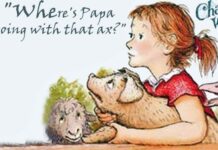ProPublica is a nonprofit newsroom that investigates abuses of power. Sign up for Dispatches, a newsletter that spotlights wrongdoing around the country, to receive our stories in your inbox every week.
This article was produced in partnership with CatchLight, a nonprofit media organization leveraging the power of visuals to inform, connect and transform communities. The collaboration was part of the CatchLight Local Visual Desk in partnership with the Institute for Nonprofit News, the McCormick Foundation, the Kresge Foundation and PhotoWings. This initiative supports news organizations and visual storytellers working together to create and share community-based visual journalism. Sign up for CatchLight’s newsletter to learn more about this collaborative model for local visual journalism.
In cities across the country, some neighborhoods still wear the scars of civil unrest. On Chicago’s West Side, the vacant lots and hollow buildings that mar the streets are often attributed to the fiery upheaval following the 1968 assassination of Martin Luther King Jr. But the West Side’s economic decline was driven by much more than the riots sparked by King’s death. A 2020 ProPublica investigation showed how this downturn was caused by other factors: a long history of disinvestment, broken government promises to rebuild, widespread demolition that outpaced construction, and rampant real estate speculation by outsiders. The Madison Street commercial corridor, once one of Chicago’s busiest business districts, suffered devastating consequences, as did the surrounding East and West Garfield Park neighborhoods, working-class communities where Black Southerners had migrated.
Yet there is more to this story than misfortune. Recognizing that these neighborhoods are often viewed through the prism of what’s been lost, Chicago-based artist and CatchLight Local Chicago Fellow Samantha Cabrera Friend and the visual media organization CatchLight collaborated with ProPublica to visually commemorate those who remain and their histories. To do this, Cabrera Friend worked with residents in East and West Garfield Park to build a citizen archive, collecting, scanning and organizing photographs from their family scrapbooks, church pamphlets and household picture frames. Using a large-format film camera, she also created contemporary portraits of participants. The resulting body of images links past and present representations of multiple generations, families and communities, and offers a reflection of them that spans decades. (Watch a discussion about the process of compiling the archive.)
Archival collections act as an official record in which people can see themselves and their place in history. To make these visuals accessible to the public an exhibition titled “Meeting History: A Garfield Park Citizen Archive” is currently on view on the second floor of the Chicago Public Library’s Legler branch, in West Garfield Park, through Nov. 15. More information about the exhibition and current hours can be found here.
Below, we present excerpts from the archives of six residents.





Annette Britton grew up in East Garfield Park in the 1960s, as white residents fled the neighborhood. Her family was working class, intent on saving enough money to build a new home and invest in the area.
Some of the handsome greystones in the neighborhood had fallen into disrepair. The family razed one of these dilapidated buildings on Washington Boulevard and Kedzie Avenue and poured the foundation for a new multifamily house, an effort documented in their pictures. Because it was the only home in the neighborhood anyone knew of that was built by a Black family, Britton’s childhood friends often thought they came from great means. But Britton and her siblings wore the same shoes so often that they grew holes in the bottom and her mother had to line them with cardboard.
Even after Britton left East Garfield Park for college and later for a job out of state, her connection to the neighborhood remained. She returned in 2010 to restore and preserve her childhood home, where she was photographed.
“I moved away a number of times and lived different places,” she said. “When I come back here, to my particular neighborhood, I find it is immensely beautiful.”



Opening photo: A view of East Garfield Park from Britton’s family home on Washington Boulevard. Archival photos provided by Annette Britton and scanned by Samantha Cabrera Friend/CatchLight Local Chicago. 2021 portrait by Samantha Cabrera Friend/CatchLight Local Chicago.

Marshall Hatch Sr. has been the pastor of New Mount Pilgrim Missionary Baptist Church in West Garfield Park since 1993. He took the job when his son, Marshall Hatch Jr., was a 5-year-old awed by the church’s high ceilings and stained glass.
“I’ve always felt like I belonged to West Garfield Park, to the church,” the younger Hatch said. As a teenager, “We’d kind of sit through church and just be thinking about, ‘Yeah, I can’t wait to go on Madison.’”


At New Mount Pilgrim, which had been a traditional Irish Catholic parish, Hatch Sr. has installed art honoring Black American history. This includes a stained glass window entitled “Maafa Remembrance” that memorializes the middle passage on a slave ship. (“Maafa” means “disaster” in Kiswahili.)
“I did understand that as monumental early on,” Hatch Jr. said about the window, “and as a contribution to the space to make us feel like we belong.”
Today, the Hatches collaborate on the MAAFA Redemption Project, a program they co-founded at the church to support young, at-risk men of color.
“I really wouldn’t want to be a church anywhere else,” Hatch Sr. said. “This is a great place to be a church and a pastor.”



Opening photo: Hatch Sr., third from left holding banner, at an April 4, 2000, march. Archival photos provided by Marshall Hatch Sr. and scanned by Samantha Cabrera Friend/CatchLight Local Chicago. 2021 portrait by Samantha Cabrera Friend/CatchLight Local Chicago.
Shacarra Westbrooks was born on the West Side. One of her first memories is of riding a tire swing at Garfield Park until she was dizzy, then being comforted by her family.
Her grandmother, a source of Deep South warmth and kindness, was the history-keeper. Like many West Siders, she arrived from Mississippi in the 1950s, when she lived through a heyday centered on Madison Street. Westbrooks experienced remnants of those times in her own childhood, but she knew them mainly through her grandmother’s stories.
“You were greeted with that warm, kind of Southern feel,” Westbrooks said. “It was the place to be.”



Today’s vacancies mix with the vibrancy of East Garfield Park in her and her family’s memories.
Now, “Madison, is like, that’s zero. When I’m driving down Madison, when I get to West Loop, I instantly feel a different change. I’m like, ‘Let me get a cup of coffee, I can stop and get something to eat.’”
But Westbrooks says there’s always hope. She owns two vacant lots with plans to make them event spaces.



Opening photo: School pictures of Westbrooks’ cousin Tamika Westbrooks for the 1995-96 school year at Marshall High School in East Garfield Park. Archival photos provided by Shacarra Westbrooks and scanned by Samantha Cabrera Friend/CatchLight Local Chicago. 2021 portrait by Samantha Cabrera Friend/CatchLight Local Chicago.


Gina Jamison’s family came to East Garfield Park from North Carolina in 1947, when her grandfather purchased land in the neighborhood. She remembers getting dressed up to go shopping on Madison Street.
Her childhood home, a red brick mansion with a porch shaded by trees, housed extended family — her grandfather, parents, aunts and uncles, plus their children — and was an important first stop for more incoming relatives migrating from the South as they got settled. She cherishes the closeness of that time.
“A lot of our family have passed away,” she said. “But I really wish that people could have that experience. We never call our aunts and uncles by ‘Aunt Estelle.’ We call them by their first name. And when I hear when people do that with their families, that’s so foreign to me. That’s how close we were.”
The house was demolished in 1988. Now on that site, Jamison tends the Kuumba Tre-Ahm Community Garden, where she was photographed with multiple generations of her family.




Opening photo: Jamison’s family home in East Garfield Park in July 1983. Archival photos provided by Gina Jamison and scanned by Samantha Cabrera Friend/CatchLight Local Chicago. 2021 portrait by Samantha Cabrera Friend/CatchLight Local Chicago.



Levette Haynes grew up in East Garfield Park. Her early memories include a first day of school at John Calhoun North Elementary School when she and her sister played the schoolyard game Pop the Whip.
“My sister let me go, and I went flying in the air and under a car. I had scraped knees … that was not my game,” Haynes said. “Even my scars come from Garfield Park.”
She moved away, returning in 1995. In some of her pictures, she poses with her granddaughter Elisheba at a garden at the Garfield Park Conservatory and at the community market.
Haynes has contributed to an effort to restore the 184-acre park, including the fieldhouse, a bandstand, the walkways and other features. She also conducts art programs and has staged theater productions there.






Opening photo: Haynes, left, at the Garfield Park Conservatory with her granddaughter Elisheba Clark in 2005. Archival photos provided by Levette Haynes and scanned by Samantha Cabrera Friend/CatchLight Local Chicago. 2021 portrait by Samantha Cabrera Friend/CatchLight Local Chicago.





LaShone Kelly was raised in West Garfield Park. She and her husband have raised 15 children in East Garfield Park. She describes her mom, a social worker, and her dad, a computer analyst, as people who cared deeply about civil rights and struggled in professions where they faced racial discrimination.
She feels she inherited a desire to correct injustices. “There are tearful moments, fretfulness and just unbelief,” Kelly said. She finds serenity in the Garfield Park Conservatory, “a place of peace to walk through and have some solace.”
Kelly recalls East and West Garfield Park as self-contained communities where everything you needed was nearby.
“The residents of Garfield want the same things as any other community. Safe spaces, good schools, amenities, healthy food,” she said. “Most people want the same thing. The residents here are no different.”

Opening photo: A civil rights march in downtown Chicago in the late 1960s. Archival photos provided by LaShone Kelly and scanned by Samantha Cabrera Friend/CatchLight Local Chicago. 2021 portrait by Samantha Cabrera Friend/CatchLight Local Chicago.
About the Photographs
All participants have granted permission to CatchLight, the Chicago Public Library and ProPublica to publish and exhibit the photographs they shared from their personal collections. While scanning, Samantha Cabrera Friend documented information about each picture by asking residents to identify people or places shown and using written or produced notes on the prints themselves (such as a date). In some cases, captions indicate a general date for the time the image was made, such as the late 1960s, reflecting the source’s best recollection, and some images could not be dated. In other cases, people have not been identified when their name wasn’t known or couldn’t be recalled.
While Cabrera Friend digitized the archival images for future preservation and is providing digital copies for the archive, the physical photographs remain in the possession of the project’s participants. We express our gratitude to them for sharing their time, and their memories and stories of East and West Garfield Park.







